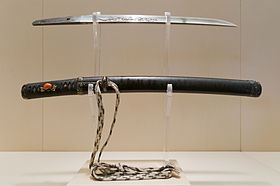The wakizashi (脇差) is a curved Japanese sword similar to the katana, but smaller, ranging in size from 30 to 60 cm. It can be worn with a katana and slipped into the belt, in which case the set is called daisho. Wealthy merchants, not being able to wear the katana, are allowed to wear the wakizashi.
Wakizashi Handling

It is wielded with one hand only, the handle being most often sized for the width of a palm. In a particular style of fencing, the Nito Ryu style, which teaches the two-sword technique developed by Musashi Miyamoto, it can be handled with the katana, and is then used as a "left hand", or as a parrying weapon.
Wakizashi Utilizations
Samurais used to carry the katana and the wakizashi on the left side, slipped into the belt, and attached by a cord (sageo), to emphasize the stability of the sheath (saya).
Samurai used wakizashi to fight in enclosed spaces. Since the blades were relatively short, the fighter had more freedom of movement than with a longer blade. Thus, the katana was used to fight in larger places (outside, large rooms...).
Practitioners of kenjutsu, and in particular of the Niten Ryu style (school inherited from Musashi Miyamoto), use a wooden wakizashi called shoto (literally: short sword) for training. It is one of the weapons of the iaidoka along with the katana and the tantō.
The fighting techniques specific to this weapon are gathered under the term kodachijutsu ("small sword techniques").
The wakizashi is especially the weapon generally used for ritual suicide (seppuku). The samurai commits suicide by incising his belly once or twice while, in some cases, an assistant called kaishakunin (or simply kaishaku) cuts off his head to cleanse him of all his offenses once the ceremony is over. This was a way to be forgiven for a fault, a refusal to obey an order.
On October 12, 1960, a 17-year-old right-wing student, Otoya Yamaguchi, murdered the socialist leader Inejirō Asanuma during a public meeting with a wakizashi - the scene was photographed and filmed by photographers present at the meeting.


